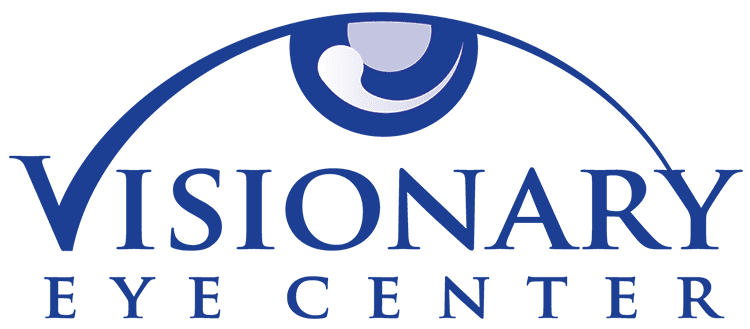SHOP DRY EYE CARE TODAY!
Use code VISIONARYEYE20 at checkout for 20% off!
It’s pretty painful to get a sunburn after missing a spot on your skin with sunscreen. Just imagine how a corneal sunburn would affect your quality of life during some of the best weather of the year. Also known as photokeratitis, this issue occurs during short-term exposure to high intensity UV-B rays. Photokeratitis is painful but temporary and is similar to a sunburn, but on your corneas (the clear portion of your eye in front of your pupil) instead of skin. It can look like a yellow, thickened area in the whites of your eyes. Too much exposure with ultraviolet rays can temporarily damage your conjunctiva, which is the clear layer of tissue covering the inside of your eyelid and whites of your eye.
Summertime activities that can put someone at increased risk for photokeratitis include mountain climbing, hiking, skiing, and swimming. It can also occur if you use sunlamps and tanning beds, or spend time in an environment with consistent UV light exposure.
There are two types of UV light proven to contribute to eye, skin, or health issues. UV-A rays can pass through your eye’s cornea to reach the lens and retina. UV-B rays can’t pass through glass but still can cause eye damage.

The symptoms of photokeratitis are pain and redness in the eyes, swelling, light sensitivity, headaches, temporary loss of vision, twitching eyelids, and seeing halos (like in the photo below). They can last from six to twenty-four hours but typically disappear after forty-eight hours.

Photokeratitis is most often formally diagnosed after an eye exam, and your doctor will place drops containing a special dye known as fluorescein in your eyes to reveal any superficial irregularities on the surface of your cornea. As for treatment, go indoors immediately after experiencing symptoms and avoid bright lights. Once in a darkened area, place a cold washcloth over your eyes and take ibuprofen. If you wear contact lenses, remove them and use artificial tears to reduce discomfort.
The longer you were exposed to UV lights, the more severe the symptoms. Long term exposure to even the tiniest amount of UV radiation can increase the risk of developing a cataract or macular degeneration (an eye disease that leads to vision loss in the center), or cause tissue elevations on the surface. These conditions are known as pinguecula and pterygium, but can be prevented by wearing sunglasses.
If you wear contacts, ask about ones that absorb UV rays when working or playing in a sunny environment. But even with these types of contacts it’s still important to wear protective sunglasses to shield your eyelids and conjunctiva from the suns’ rays.

The good news is that photokeratitis is preventable simply by wearing the proper eye protection when outside, like prescription sunglasses or snow goggles in the winter. Glare from snow, sand, or water can cause burns to your eyes even if it’s overcast. A wide brimmed hat can help filter out the sun’s rays as well.
When purchasing a pair of sunglasses, it’s worth noting that not all sunglasses are polarized. Polarized sunglasses are manufactured in a distinctive way that creates a different pattern in the lens to block out more light than a usual pair of sunglasses. When choosing a pair, look for one that provides one hundred percent UV protection or UV 400 protection. Prescription sunglasses help with overall light sensitivity, headaches caused by glare, and regular eye strain from squinting in bright sunlight.
For more information, check out our other blog post on prescription sunglasses here.
Be sure to visit your eye specialist once a year to stay up on your eye health and catch any issues early. It’s never been a better time to make an appointment with the team at Visionary Eye Center to get the perfect pair of prescription sunglasses for your summer adventures.
Our Reno eye care facility is one of the best in preventing photokeratitis in our patients.
Schedule an Exam with an Eye Doctor in Reno
It’s August, and that means it’s National Children’s Vision Month! Back-to-school season is also here, and there couldn’t be a better time than before your child returns to the classroom to take them to the eye doctor. One out of four school-age children suffer from some type of uncorrected vision problem, which can seriously impair their success in the classroom. Children are not always able to recognize by themselves that blurry vision or struggling to see near or far is actually a concern. And vision problems aren’t always issues with blurry vision, but rather eye alignment and focusing issues that lead to struggles in school, despite the fact they can see the classroom board clearly.
A routine school eye screening by an optometrist is necessary to detect vision problems and maintain overall optical health. You may have believed a school or pediatrician vision screening is enough. These are brief exams that evaluate visual acuity, the ability to read small letters or see a picture on a chart. These screenings are not comprehensive and can’t evaluate the way your child’s eyes work while reading or doing school work, nor can they adequately evaluate your child’s eye health. This means many vision problems aren’t detected, contributing to your child struggling in their academics or athletics.

According to the American Academy of Ophthalmology, it’s recommended that children receive an eye evaluation once before the age of 3, and at least every one to two years until the age of 19. Preschoolers should see a pediatric optometrist to ensure their eyes are aligned and focusing properly to address developing issues and halt progress down the road. During adolescence, a person’s eyesight can change rapidly and often, especially impacted by puberty, so they should continue to receive annual checkups. Of added importance, detecting myopia early is key as we now have FDA-approved technologies like the MiSight lens to slow the progression of near-sightedness or myopia. So we can now actually do something about your child’s prescription getting worse every year using myopia control techniques.
Scheduling an eye exam with your child’s optometrist before school begins will ensure they start the school year with the best overall vision to succeed! It eliminates the concern that vision or eye health could be interfering with your child achieving their highest academic potential. Proper eyesight can also prevent headaches, fatigue, and lack of focus in the classroom. You should also have your child’s lens prescription checked and kept up-to-date, especially if they are active in team sports or have a new classroom seat each year. Being proactive in ensuring your child regularly visits an optometrist is essential. After all, they own their eyes for life!
 775.827.1100info@visionaryeyecenter.com8175 South Virginia Street Suite B-900
775.827.1100info@visionaryeyecenter.com8175 South Virginia Street Suite B-900